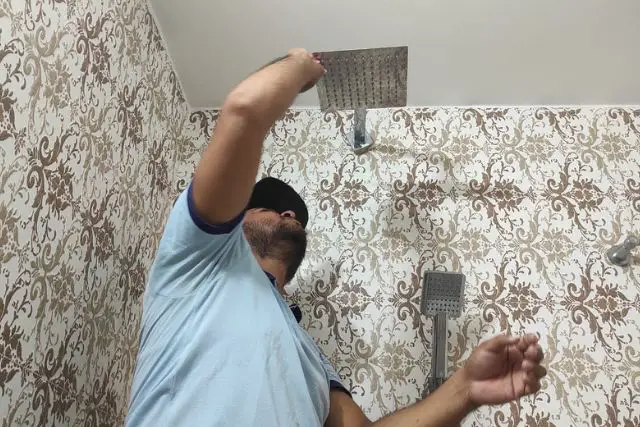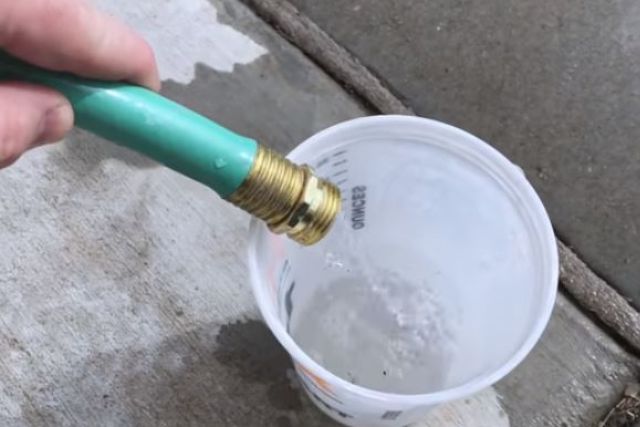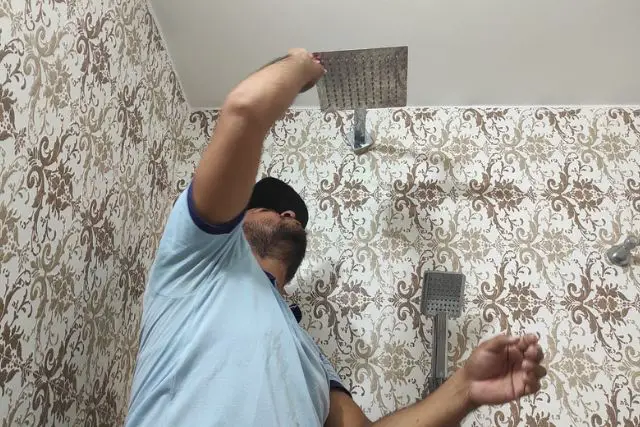Beyond any doubt, having a shower with lower or inconsistent water pressure is enough to cause a frustrating shower experience for you. Whether you are dealing with a weak drizzle or fluctuation in flow rate, it is essential to learn how to fix water pressure in shower.
But the good news is that you can easily get rid of this trouble by following some effective DIY solutions. That includes:
- Cleaning the clogged showerhead
- Properly adjusting or replacing the defective shower valves
- Repairing corroded or leaky plumbing pipe
- Replacing old pipe or removing flow restrictor
- Adjusting the water pressure regulator
- Opening the water shut-off valve all the way

Don’t assume the end here! Throughout our comprehensive guide, we’ve also got you covered with some professional solutions and tips to improve your shower water pressure.
So, let’s dive right in.
How To Test Water Pressure For A Shower?
If you suspect a malfunction in the water pressure of your house, it is essential to test the water pressure before approaching any troubleshooting steps.
It will provide clear insights into where the water pressure is too high or too low and help to take the necessary solving action.
Anyway, to measure the current pressure, here are the simple steps to follow:
Step #1: First up, you will need a 1-litre measuring jug. Place the jug under the problematic shower.
Step #2: Turn on the shower all the way.
Step #3: Now take your stopwatch and start the timer.
Step #4: Then time how long it takes to fill the jug. It would be within 6 seconds, signaling to you that the water pressure is all right.
Step #5: If it takes longer than 6 seconds, your shower is running at a low water pressure.
However, to get a more accurate measurement, consider using a pressure gauge. It would be highly available in your local hardware store or online retailer. It is quite simple to use.
Screw or attach the gauge to the showerhead where you want to measure the pressure. But make sure the shower is in the normal operating condition.
Now turn on your shower faucet to allow water to flow. With the water flowing, read the pressure displayed on the gauge. It would be in pounds per square inch (psi). to get an accurate reading, it is better to take multiple measurements at different times
What Is The Normal Pressure A Shower Should Have?
Water pressure from the shower should be adequate enough to enjoy a pleasant showering experience. The average pressure range of a shower should be within 40 to 60 pounds per square inch (psi). The water below 40 psi is generally considered low and pressure above 80 psi is considered too high.
However, while 40-60 psi is the ideal pressure range for your home plumbing system, it can vary by your location and the type of fixtures you are using.
In general, flow fixture or water-saving faucet models are designed at lower pressures where the power fixtures ensure comparatively higher pressure than the normal range.
Even if you are measuring the pressure at peak usage times in your area like in the morning and evening, you may get drops in pressure measurement due to an increased water demand.
Major Reasons For Low Water Pressure In Your Shower [Easy Solutions]
If your shower water pressure seems low, several factors are contributing to irregular or poor pressure. Here I’ve the most common reasons along with some insights into how you will deal with the issues to restore the adequate water flow rate.
1. Clogged Shower Head
In case of low shower water pressure, clogged or blocked shower head is the root culprit to blame. If you notice, you will find a screen attached to your bathroom shower that directs the spray of water out.
Over time, it is clogged with dust and mineral accumulation, resulting in reduced water flow or low water pressure in your shower. It is even the most common phenomenon if you are living in a hard water area, containing high levels of dissolved solids like calcium and magnesium.
When this water passes through your shower, it ends up sticking to the metal and plastic screen of your shower.
Don’t get panicked! A thorough cleaning will be enough to resolve the issue. Here is all how to clean a clogged showerhead:
How To Fix:
Step #1: Start by turning off the water supply to your shower.
Step #2: Disassemble the shower head from the connection.
Step #3: Now take a container full of white vinegar and soak the showerhead in the vinegar for a few hours. It will help you to dissolve the mineral buildup easily.
Step #4: Use a soft-bristle brush and a toothpick to clean up any remaining debris from the shower head opening. Rinse with clean water and reassemble it back to its connection.
Step #5: In case, if it seems hard to disassemble the shower head, you clean it attached to its connection. For instance, simply wrap a plastic bag with vinegar around the shower head and leave it for a few hours.
2. Worn-out Mixing Valve
If you have a single-handle shower faucet, then you will have a thermostatic mixing valve that is designed to blend hot water with cold water to ensure constant temperature.
While the mixing valve doesn’t directly impact water pressure, it can influence the hot and cold water flow rate in case the valve is stuck or worn out.
Over time, the internal components of a mixing valve wear out due to regular use, leading to issues with water flow.
If the hot and cold water flow from the mixing valve has low pressure, it also results in mixed water coming out of the valve also having lower pressure.
How To Fix:
First off, turn off the water supply to your shower. Now disassemble the shower handle and get access to the mixing valve. Verify the valve is in well working condition.
If not, bad mixing valve replacement is the only way to resolve the issue. But while replacing make sure the valve is installed correctly. Otherwise, it may not function as intended.
For instance, you can contact a professional plumber. In general, a typical shower valve replacement will cost you around $250 – $400, including the replacement part.
3. Malfunctioning Pressure Balancing Valve
The pressure balancing valve is the essential device of most of the single-handle shower faucets that regulates the volume ratio of hot water to cold water. After sensing the water flow, it adjusts the rate to continually deliver water at your desired temperature.
Now in case of a malfunctioning pressure balancing valve, it would be an obvious reason for limiting the water flow rate from your shower.
The best chances are it is not adjusted properly or worn out at all. In normal cases, you will find sediment and mineral accumulation in the valve’s components that may be obstructing the valve’s operation.
Whatever the fact is, let’s track down how you will deal with the malfunctioning pressure balancing valve.
How To Fix:
First off, remove the shower handle and access to your pressure-balancing valve assembly. Inspect the valve for debris and sediment accumulation.
If you notice this clog, simply clean it using a soft brush or you may soak it in a solution of vinegar and water to dissolve mineral buildup. After cleaning,
- Examine the valve for any visible defects or damage. Look for signs of corrosion or leakage due to loose components.
- Tighten any connections or fittings as needed and test the water flow rate.
- If still the situation, be sure, the valve is effective and you need to replace it. Consult a professional plumber to get this job done easily.
4. Faulty Water Heater
While dealing with the same issue in my bathroom fixture, I literally surprised that my water heater was the leading factor for causing low shower water pressure. Even it is the most obvious reason to blame if you are struggling with hot water pressure low but cold fine in the shower.
The best chances are your water heater is accumulated with the mineral build-up. If there is an accumulation of sediments in your hot water tank, it has to work harder to heat the water through the sediment layer.
This results in slower hot water delivery in your shower.
Besides this, using kinked water pipes or leakage in the water heater can also result in sudden low water pressure in the shower. In some cases, an undersized water heater reduces the volume of hot water you need.
How To Fix:
First off, inspect your water heater for hard mineral buildup. If so, be sure it is time to descale and flush your water heater unit.

When done, check for developing leaks around connections, valves, or the tank itself. Tighten the loose connection or repair the defective parts.
Plus, verify that you are using the correct size water heater to ensure adequate volume of hot water delivery as your household demands. For instance, you can consult a plumber to see if your unit needs to be repaired or replaced.
5. Defective Water Pressure Regulator
A water pressure regulator is a pressure balancing device, installed in every residential water supply system that is designed to maintain the water pressure entering the house.
If the pressure regulator is not adjusted correctly, it is sure you will notice a sudden drop in water flow rate throughout the fixture including the shower.
How To Fix:
If you suspect that a malfunctioning water pressure regulator is causing low shower pressure, start by verifying that it is adjusted correctly. If not, adjust the water pressure regulator it by turning the screw or lock nut clockwise and increasing the pressure.
In most cases, you may need to replace the bad regulator.
6. Partially Closed Water Shut-off Valve
There are several water main shut-off valves in a plumbing system that control the flow of water into your entire home. In any case, if any of the valves is closed or not fully open. It restricts the flow of water through the pipe, resulting in reduced water pressure at the shower and other fixtures.
How To Fix:
Locate the main shut-off valve of your house. Turn the valve handle counterclockwise to open it all the way and check the water flow.
7. Corroded Or Leaky Pipe
If you are still struggling with the low water pressure issue from your shower fixtures the higher possibility is you have a corroded or leaky plumbing pipe.
Over time, the water pipes corrode or rust from the inside after long use, especially the ones that are made from metal. Besides, if you are living in a hard water area, mineral deposits easily get stuck in water supply pipes and disrupt the flow to your shower.
In worst cases, you will find the water pipe is leaking or fracturing. As with the water escaping through the leaks, less water will be able to reach your shower heads.
How To Fix:
As for the first step, inspect the water pipes of your house for rust, debris, or sediment buildup. Also, look for hidden leaks in the plumbing system. It would be within the walls or under the floor and in some cases may not be immediately visible.
Thus it is tough enough to deal with the cored or leaked water pipes on your own. For instance, it’s better to contact a trained, professional plumbing technician in your area.
The Importance Of Proper Water Pressure In Your Home
It is essential to maintain consistent water pressure throughout your plumbing system and household appliances to ensure a convenient and hassle-free daily life. Either it shouldn’t be too low or too high.
Lower water pressure is a nuisance in your home and you will experience an abnormal flow of water. It disrupts your household in several ways. Not only showers can take longer but also it takes longer to run the cleaning cycles to a washing machine or dishwasher.
Besides this, you will find malfunctioning in the flushing efficiency of toilets. The toilet won’t remove waste properly leading to clogs in the drainage system.
Plus, low water pressure fasters the rate of hard water mineral buildup that causes rust and corrosion in the plumbing pipes.
Conversely, if you have high water pressure, it wouldn’t directly disrupt your household but lead to several damages in the plumbing system. Like:
- Cracks, holes, or small leaks in the plumbing fixtures
- Developing leaks in the pipes, joints, and seals.
- Running toilet due to excessive pressure
- An abnormally high water utility bill,
- Loud sounds like banging or knocking noises coming from your plumbing
- Banging or “water hammer” noises when you turn on or off the faucets
- Shortens the lifespan of the water heater, washer, dishwasher, or other related appliances
- Increase the risk of water damage and pipe bursts.
How To Fix Water Pressure In Shower [Easy Ways]
Having settled with the slow drizzle in your home plumbing fixtures are never a good deal. For your convenience, here I’ve brought a few smart ways to boost up the water pressure in your shower:
i). Clean The Shower Head
Periodically inspect and verify your showerhead to ensure if it isn’t clean enough. Over time, water flows through the showerhead openings leaving mineral deposits and developing clogs.
Depending on the severity of the problem, the problem can easily be resolved by a thorough cleaning with the vinegar and water mixture. We’ve discussed the cleaning processes in the earlier part of our discussion.
ii). Adjust Or Replace The Flow Restrictor
Check for a flow restrictor in your shower head. After long use, it is obvious mineral build-up around the restrictor. If so, consider regularly cleaning the flow restrictor. After cleaning, make sure you have adjusted the flow restrictor correctly.
Or, depending on your current water flow better you can remove the flow restrictor at all to increase the pressure rate. After removing the restrictor, put the shower head back in place and test the flow rate.
iii). Check The Main Water Shut-off Valve
Regularly check the water shut-off valve of your house to ensure that it is opened all the way. If it is partially closed, fixtures like faucets, showers, toilets, and appliances won’t get an adequate amount of water.
As a solution, turn and set the valve lever parallel to the water pipe e to open your water supply full. Check for obstruction in the water shut-off valve and remove it.
iv). Adjust The Water Pressure Regulator
As earlier mentioned, a water pressure regulator plays a crucial role in maintaining the water flow rate throughout your home plumbing system. Thus it is essential to inspect the regulator adjustment to see whether it is set correctly.
Simply turn the lock nut clockwise (right) to increase water pressure. But avoid overdoing it as too much pressure can damage the water pipes and shower faucets.
v). Check For Kinks Or Leaks In The Water Pipes
Kinked or leaked water pipes in the plumbing system are the major reason for causing low water pressure. Start by inspecting the shower hose to see whether it is kinked.
Even if you have the shower attached with the plastic hose, it is normal for the hose to get folded, or crease if pulled at the wrong angle. If so, consider replacing the hose as soon as possible.

Besides, verify your household water pipes to identify any leakage or damage. We recommend calling the plumbing professionals if you find any leaked pipe to fix it.
vi). Descale And Flush Your Water Heater
If you have a water heater in your house, concentrate on the proper maintenance of this heating device to maintain adequate hot water for home appliances. For instance, consider flushing your water heater at least once or twice a year. It will help to descale the sediment build up in the unit and remove any debris in the pipes.
vii). Consider Taking Shower During Off-peak Periods
One of the easiest ways to ensure adequate water pressure is using fixtures during off-peak periods. Peak hours of the day would be the morning when most of the people are showing up or getting ready before heading off to work.
Besides the morning, late afternoon and early evening are considered the peak hours of the day. Try to avoid using a shower during the peak periods and test the water pressure of your house at other low-use periods.
Professional Tips To Increase Water Pressure In Your Shower?
If you are still struggling to get the high water pressure in your house, you can try some professional solutions in this instance:
viii). Install A High Pressure Shower Head
Start by upgrading your existing low-flow water shower fixture with a high-flow one. It will be enough to ensure high water pressure throughout your home plumbing system.
It is an eco-friendly option as well through which you can save the water and ultimately save the water bill on the higher end.
The best advantage is you will get showerheads in various designs like rainfall showerheads and adjustable models. You can choose models that suit your style and preferences.
xi). Install A Shower Pump Or Pressure Booster
Installing a water pressure booster or shower pump is an effective method to boost the water flow rate of your home plumbing fixtures. Water pressure boosters or shower pumps can be installed in the main water supply lines of your house.
The devices are specially designed to increase water pressure and flow rate in your shower or other fixtures.
Most of the shower pumps equip sensors and controls to monitor water pressure. When the sensor detects that the incoming water pressure is lower than the normal range, it activates and draws water from the supply source.
And once it reaches the desired level, it will shut off automatically and remain off until it’s needed.
Some pressure boosters come with adjustable settings that allow you to control the level of pressure increase and flow rate of water.
x). Consider Upgrading Your Plumbing System
If it’s too long a time with your plumbing system, be sure it’s old and outdated. Also, over the years, pipes can corrode and develop leaks and cracks due to corrosion.
Note that, using old and damaged plumbing fixtures is another major reason for causing low water pressure, leaks, and even water damage.
By simply upgrading to a modern plumbing system, you can easily resolve these issues. Though it seems like a significant expense, ultimately the result would be totally different. Modern plumbing fixtures are designed to be more water-efficient which helps you to reduce water waste and lower utility bills.
The Best Shower Pump To Increase Water Pressure
If you are on the hunt for the best shower pump, there are several good options in the market to choose from. But choosing the right shower pump will depend on the type of central heating and hot water system of your house and the type of shower you have.
Here we have an effective list for you about the best and most powerful shower pump in 2023 for increasing the water pressure of your house:
| Best Shower Pump | Pressure |
| Showermate Eco Twin Shower Pump | 1.5 Bar |
| Bristan ST PUMP15TN Shower Pump | 1.5 Bar |
| Salamander Pumps | 2.2 Bar |
| Monsoon Standard Shower Pump | 3.0 Bar |
FAQs:
How much does it cost to install a shower pump?
The cost to install a shower pump is calculated by multiplying the number of plumber working hours by the general hourly rate in your local area. In most states in England and the US, the plumbers charge between £50-£100 per hour.
Can I increase the water pressure in my shower without calling a plumber?
Yes, definitely, by following some effective DIY methods, you can easily boost up the water pressure in your shower system. For instance, you may go through our guide. But in case you continue to experience low water pressure, it‘s better to call a plumber.
How much will it cost to install a high-flow Showerhead?
Usually, the cost of the high-flow shower head will range between $25 – $150. While you can easily install it yourself by following some DIY methods, you can call a plumber as well. The cost of shower head installation for plumbers is roughly around $50 to $100.
In Closing!
There is almost nothing frustrating like that you are experiencing low water pressure in your shower. It doesn’t only take longer to complete your shower but also enough to cause water damage and most importantly your time. That’s the point, the first query would start on how to fix water pressure in shower.
Well! After thoroughly reading our comprehensive guide, hope it will be enough to resolve the abnormal water pressure issues in your shower. As with properly maintaining the steps and suggestions mentioned above, you can hopefully enjoy an improved shower experience with consistent water pressure.
Note: You can also read our ultimate guide on can a bad shower cartridge cause low water pressure.


About Atikul
Atikul Islam shares his expertise with various tips & tricks to fix the problems with home appliances related to toilet, kitchen, bathroom, heating, & cooling systems. Read to know more about Atikul Islam.